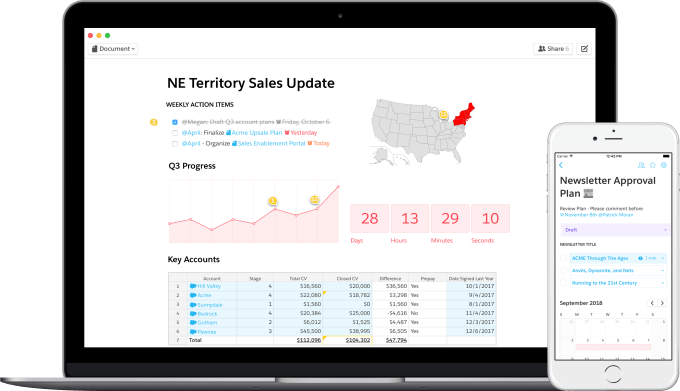When Salesforce bought Quip, a document-based, mobile-first collaboration tool for $750 million last September, it may have seemed like an odd purchase, but Salesforce and Quip have been hard at work enhancing the product. Today at the Dreamforce customer conference in San Francisco, the company announced significant updates to the product designed to make it more of a central way to collaborate in the enterprise.
For starters, Quip users will have the ability to store live data like a calendar, Salesforce customer record, or Kanban project management board. Being live means, if for instance someone changed the source Salesforce record, it would update automatically in the Quip document. Conversely, if the user changed the record in Quip, it would update in Salesforce.
The company also announced a new Live App API, so customers or third parties can build live app connectors into Quip beyond the ones Salesforce is providing out of the box. Early partners include Atlassian Jira, DocuSign, Lucidchart and New Relic where the various data types can reside as live data inside Quip. Customers can access these tools from the all-new Quip App Store, which the company is also announcing today.

Photo: Salesforce
Bret Taylor, Quip founder and CEO, says the integration involves a couple of lines of Javascript, but it also gives developer partners access to core Quip services. “The platform is technologically advanced. We have exposed the building blocks of Quip that are core of the Quip technology. When you write a live app, it automatically supports real-time code,” he said. Similarly, developers can access the Quip rich text editor, @ mentions and comments, and build them into apps when it makes sense.
It’s also introducing new workflow templates that are designed for specific tasks with a set of Live tools geared to the needs of that specific activity. For example there are templates for developing a product roadmap, preparing for a new product launch and mapping out sales territories. The company is planning future templates around territory planning workflow for sales managers, launch planning for marketing teams, and a product roadmap for product managers.
The idea of all these new tools is to be able to enhance and extend the base Quip product and make it a center of collaboration. While that sounds a lot like what Slack is trying to do, Taylor doesn’t see his company competing directly with Slack. “We continue to view Slack as a really close partner. Slack and Quip are really driven by the vision that companies can be productive without email,” Taylor explained.
Everywhere you look in the enterprise, collaboration has taken a central role. Slack seemed to wake enterprise collaboration tools from the doldrums. Since it came along, all of the big companies are taking on this area from Workplace by Facebook to Microsoft Teams to Google Hangouts to Atlassian’s various collaboration offerings (Hipchat, Confluence and Jira). It probably shouldn’t come as a surprise that Salesforce wants a piece of this action.
But Taylor believes that these tools can and will co-exist. For instance, Facebook is one of Quip’s largest customers. “Over 30,000 people at Facebook use Quip every single week and Facebook has deeply integrated Quip into Workplace by Facebook, the company’s enterprise collaboration tool,” he said.
For now, it seems that today’s announcements are about enhancing the original Quip product to become more like the rest of the Salesforce family with the ability to customize and build on top of the core product while also providing ways for companies to hit the ground running.
Workflows and Live Apps are available today. The Live Apps API is currently in Beta. Salesforce has not announced a target release date as of yet.
